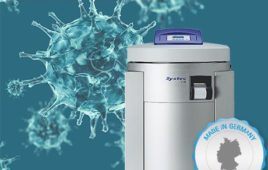Is it appropriate to test an ESD garment on an operator?
This question was asked of Larry Levit during an “Ask the Experts” panel discussion at ESTECH, the annual technical meeting of the IEST (Institute of Environmental Science and Technology). Larry teaches a tutorial “ESD the Unseen Contaminant in the Cleanroom” for the IEST. Larry answered “Yes, but the results will be different when the ESD garment is worn versus when tested at the laundry for surface resistivity and triboelectric charging. Different environments will give different results.” q=CV where “q” is the charge on the garment; “V” is the voltage that is read on the static meter, and “C” is the capacitance of panel to ground. If the panel is near a person or grounded metal piece then “C” is a large numeric value. If there is nothing near the panel such as the garment hanging on a plastic hanger with three-foot spacing around the garment, then “C” is a very small number indeed. Therefore, “V” is a large or small numeric value depending upon the environment and the ESD garment will respond differently when worn on a person rather than on a hanger. The person is the capacitance. For that reason, it is not reasonable to set the same voltage limits on a garment on the rack because it does not represent the conditions in which the garment is used. Garments on the rack OVERESTIMATE the amount of charging that a garment will exhibit when worn, sometimes even by a factor of 10.
ESTABLISHMENT OF AN ESD CONTROL PROGRAM
There are several reasons to establish an Electrostatic Charge (ESC) Control program. Electrostatic charge causes damaging electrostatic discharges (ESD) and the attraction of contaminants or electrostatic attraction (ESA). In the disc drive, flat panel display, and semiconductor industries, static electricity can cause immediate or latent failure of the product through ESD or ESA. Therefore, it is imperative to control static electricity in cleanrooms and controlled environments.
Controlling static electricity and electrostatic discharge should be a multi-faceted approach. Each individual parameter supports the total ESD program. An ESC control program involves use of special personnel apparel, shoes, or grounding straps, ionizers, control flooring, work surfaces, and packaging. All surfaces that have some electrical conductivity should be grounded and insulative surfaces should be avoided. In some cases, temperature and humidity can be used to also decrease static charging. It is impossible for any one of the above components to individually control static electricity. Therefore the program should take into account:
- What is reasonable?
- What is enough?
- How to take the specifications and make them work.
- Common sense techniques based on the physics of what is happening.
THE BEST DEFENSE IS EDUCATION OF THE OPERATOR AND THE ENGINEER
People working in cleanrooms or controlled environments, as well as production materials and automated machinery in the cleanroom or controlled environment, are the major generators of static electricity that will compromise the integrity of the product and the process. Operators damage products by building a charge on themselves or on an adjacent object by abusing static control measures, often inadvertently. Figures 1 and 2 show operators defeating the static control program accidentally or through ignorance. Engineers often design manufacturing steps and processes using unsafe practices, also without knowledge of the issue. It is also true that engineers often are aware of static control techniques and ignore them for expediency. Figures 3 and 4 show process steps that were specified by an engineer without regard for electrostatic charge control.
Regular auditing of your operators and operation is the best method for assessing the status and effectiveness of your ESD program.
Therefore, the training of personnel on the electrostatic control program is critical to the success of the program. Operators need to know what is expected of them and why. Engineers need to know what is and is not to be included in the process and why. They are often the worst offenders. Once the engineers go from offenders to defenders, yield improves and they often become evangelists. Managers also need to know “what and why” at a general level so that they can support the program. Each group needs a different training course.


YOU CAN’T CONTROL WHAT YOU DON’T MEASURE
The Institute of Environmental Sciences and Technology recommended practice IEST-RP-CC022.2, “Electrostatic Charge in Cleanrooms and Other Controlled Environments,” is an excellent resource to enable you to understand ESD garments and associated ESD control measures. Additionally, the Electrostatic Discharge Association ANSI/ESD S2020-2007 is a good reference document for building a static control program.
The ESD Association offers detailed recommended practices (RPs) and Standard Test Methods (STM) such as test method in ESD STM 2.1. “For the Protection of Electrostatic Discharge Susceptible Items – Garments – Resistive Characterization.” This standard describes the methods to test the efficacy of the static control garments and recommends that groundable static control garments meet the specifications of 1.0 X 105 Ohms to 1.0 X 109 Ohms. The specifications for static control garments are 1.0 X 105 Ohms to 1.0 X 1011 Ohms.
There are three types of static control garments for cleanrooms and controlled environments. Some static control garments can be connected to a groundable point and some static control garments establish an electrical path to the groundable point. However, the most commonly used static control garment establishes electrical resistance from one point or panel to another point or panel within the garment.
Static dissipative garments for cleanrooms are designed for particle entrapment as well as static dissipation. Therefore, the fabrics, ESD yarns, and seam construction of ESD garments for cleanrooms are different than the fabrics, ESD yarns, and seam construction of ESD garments for controlled environments. Flat-feld seam construction is recommended for durability and efficacy to meet ESD STM 2.1 point-to-point specifications across seams while the garment is in use and the sewing of pockets and emblems are not recommended as they may break and ultimately compromise the ESD yarn in the fabric.
Specially designed ESD shoe covers, heel straps, or shoes are used to impart some ESD control when a facility has a dissipative grounded floor. Grounded static dissipative garments, when worn correctly, are designed to minimize the charges that may or may not be present on an operator’s undergarments. However, it is recommended that other measures of ESD control are also used.
Wrist straps are typically used to control static electricity on personnel working in and around ESD sensitive materials. When properly worn and connected to ground, a wrist strap keeps the person wearing it near charge neutral. Daily testing and/or continuous monitoring of the wrist strap connection with the operator is recommended in ESD STM 2.1.
Dissipative casters or wheels are used to enable control of static electricity on carts and chairs. These are used in combination with grounding foot straps and ESD conductive flooring to reduce triboelectric charge when movement of carts and personnel is required during the production process.
Air ionizers are used to control static electricity by neutralizing the static charge on objects that they contact.
Temperature and relative humidity are usually controlled for optimum manufacturing or sometimes for operator comfort. The temperature in a cleanroom is typically 68°F +/- 3ºF (16ºC–21ºC) with a relative humidity of 35–65%. If the relative humidity is less than 30%, the incidence of static discharge is dramatically increased. Therefore, if possible for the process, the humidity should be kept higher.
Packaging materials (shielding bags or boxes) provide direct protection of the ESD sensitive device if it is constructed of shielding materials. In contrast, insulating bags are a well known ESD hazard for microelectronics. ESD shielded bags are often constructed in a “sandwich” fashion using a metalized outer layer to create a Faraday Cage. The inside of the packaging is usually a layer of conductive material with the outside surface constructed of static shielding material.
ESD STM 2.1 – 2009 recommends that the durability and efficacy of the garment and/or garment system is evaluated during the Qualification testing using the point-to-point test method. Validation of a reusable ESD garment will require an audit of the laundry service provider. The durability, efficacy, and reproducibility of the ESD garment and/or garment system over time is evaluated during the Performance Qualification or weekly testing. The same point-to-point testing and established parameters used to evaluate the ESD garment and/or garment system during the Qualification phase are performed to establish documented evidence of durability, efficacy, and performance of the static control garment while in use.
I want to thank Larry Levit for his expertise and contribution to this column. Larry may be contacted at [email protected]. His web site is www.LBLScientific.com.
Jan Eudy is an IEST Past-President. She is also Corporate Q.A. Manager for Cintas Cleanroom Resources.



